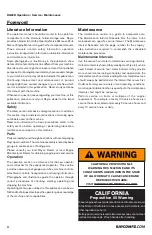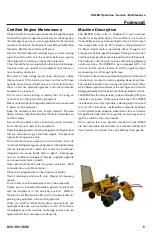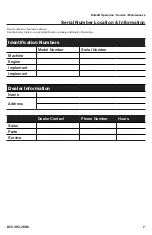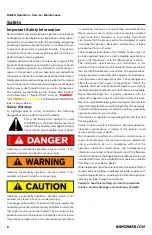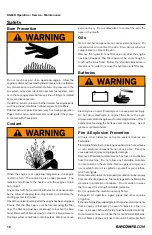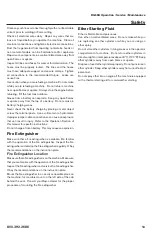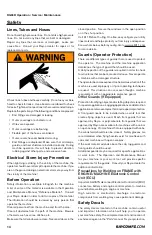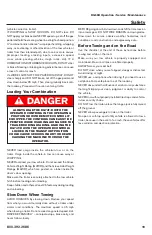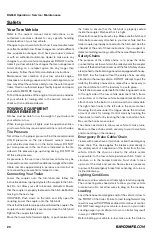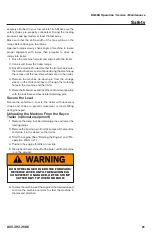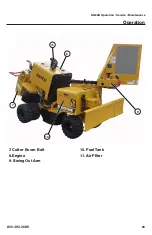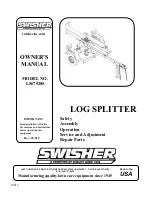
RG55R Operation • Service • Maintenance
10
Safety
Pressurized Air and Water
Pressurized air and/or water can cause debris and/or hot
water to be blown out.
This could result in personal injury.
When pressurized air and/or pressurized water is used for
cleaning, wear protective clothing, protective shoes, and eye
protection. Eye protection includes goggles or a protective
face shield.
The maximum air pressure for cleaning purposes must be
reduced to 205 kPa (30 psi) when the nozzle is deadheaded
and the nozzle is used with an effective chip deflector and
personal protective equipment. The maximum water pressure
for cleaning purposes must be below 275kPa (40 psi).
Never use compressed air for cleaning.
Trapped Pressure
Pressure can be trapped in a hydraulic system. Releasing
trapped pressure can cause sudden machine movement
or attachment movement. Use caution if you disconnect
hydraulic lines of fittings. High pressure oil that is released
can cause a hose to whip. High pressure oil that is released
can cause oil to spray.
Fluid penetration can cause serious injury and possible
death.
Fluid Penetration
Pressure can be trapped in the hydraulic circuit long after
the engine has been stopped. The pressure can cause
hydraulic fluid or items such as pipe plugs to escape rapidly
if the pressure is not relieved correctly.
Do not remove any hydraulic components or parts until
pressure has been relieved or personal injury may occur.
Do not disassemble any hydraulic components or parts
until pressure has been relieved or personal injury may
occur.
Refer to the Service Manual for any procedures that
are required to relieve the hydraulic pressure
Always use a board or cardboard when you check for a leak.
Leaking fluid that is under pressure can penetrate body
tissue. Fluid penetration can cause serious injury and
possible death.
A pin hole leak can cause sever injury.
If fluid is injected into your skin you must get treatment
immediately. Seek treatment from a doctor that is familiar
with this type of injury.
Dispose of Waste Properly
Improperly disposing of waste can threaten the environment.
Potentially harmful fluids should be disposed of according
to local regulations.
Always use leak proof containers when you drain fluids. Do
not pour waste onto the ground, down a drain, or into any
source of water.
• Tools that are suitable for collecting fluids and equipment
that is suitable for collecting fluids
• Tools that are suitable for containing fluids and equipment
that is suitable for containing fluids
Asbestos Information
Rayco recommends the use of only genuine Rayco
replacement parts. Use the following guidelines when you
handle any replacement parts that contain asbestos or when
you handle asbestos debris.
Use caution. Avoid inhaling dust that might be generated
when you handle components that contain asbestos fibers.
Inhaling this dust can be hazardous to your health.
The components that may contain asbestos fibers are brake
pads, brake bands, lining material, clutch plates, and some
gaskets. The asbestos that is used in these components
is usually bound in a resin or sealed in some way. Normal
handling is not hazardous unless airborne dust that contains
asbestos is generated.
If dust that may contain asbestos is present, there are several
guidelines that should be followed:
• Avoid brushing materials that contain asbestos.
• Avoid grinding materials that contain asbestos.
• Use a wet method in order to clean up asbestos material.
• A vacuum cleaner that is equipped with a high efficiency
particulate air filter (HEPA) can also be used.
• Use exhaust ventilation on permanent machining jobs.
• Wear an approved respirator if there is no other way
to control the dust.
• Comply with applicable rules and regulations for the
work place, In the United States, refer to Occupational
Safety and Health Administration (OSHA) requirements.
• Obey environmental regulations for the disposal of
asbestos.
• Stay away from areas that might have asbestos particles
in the air
Summary of Contents for RG55
Page 27: ...RG55R Operation Service Maintenance 800 392 2686 27 Operation ...
Page 58: ...RG55R Operation Service Maintenance 58 Hydraulic Schematic 805921 ...
Page 59: ...RG55R Operation Service Maintenance 800 392 2686 59 Hydraulic Schematic 805921 ...
Page 67: ...RG55R Operation Service Maintenance 800 392 2686 67 Specifications ...




